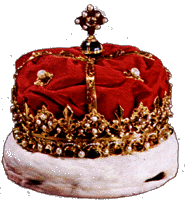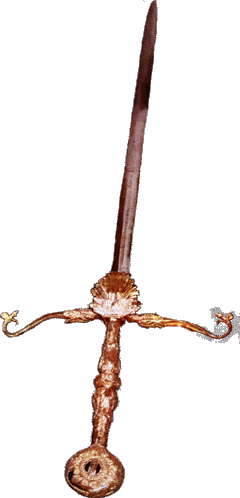

The Honours of Scotland
Copyright (c) 1998
Royal Stuarts
All Rights Reserved
Royal Stuarts
All Rights Reserved

The Crown which today rest in the Crown Room of Edinburgh Castle was remodelled by order of James V in 1540, but there is no precise evidence of its antiquity.
In the accounts of the Lord high Treasurer of Scotland there are recorded payments in 1532 and 1533 for gold to men the Crown, and on the 15th of January 1540, to John Mosman, a goldsmith in Edinburgh, for the making and fashion of the King's Crown and for twenty-three stones supplied for it.
The four golden arches of the Crown are ornamented with gold and red enamelled oak leaves, apparently of French workmanship. At the point where the arches meet there rests a mound or celestial globe of gold, the sign of sovereign authority and majesty which is enamelled in blue and ornamented with gild stars. This is surmounted by a large cross decorated in gold and black enamel withan amethyst in rectangular form in the center. The upper and two side extremities of the cross are adored with find Oriental pearls.
It is generally accepted that the gold of which the Crown is composed was obtained partly, if not entirely, from Scottish mines-probably from those of Crawford Moor, which were active about the period whien the Crown was remade.

The Sceptre was originally a gift from Rome, having been presented along with a gold rose by Pope Alexander VI to James IV in 1494. It was refashioned by James V, whose initial are engraved on the upper portion of the lower rod.
The rod, which is of gilded silver, is hexagonal and in three divisions, the end division forming the handle. The decond division is ornamented on three sides with engraved fleurs-de-lis and thistles, while the upper division is decorated with grotesques, cups and foliage.
The head of the rod is flanked by dolphins, with small figures in between. The first of these represents the Virgin Mary, crowned with an open crown, holding on her right arm Our Saviour and in her left hand a mound, ensigned with a cross. On her left hand is St James, clad in a loose flowing robe and cape. To his left is St Andrew's Cross or saltire, the upper portion of which is broken off.
The globe is a rock crystal, cut and polished smooth, and is surmounted by a small oval globe with a Scottish pearl fixed on top.

The Sword of Stage was presented by Pope Julius II to James IV in 1507. It ws accompanied by the sword belt and a consectrated hat, and they were delivered with great solemnity in the Church of Holyrood by the Papal legate and the Abbot of Dunfermline. It is a fine specimen of craftsmanship and belongs to the period when the art of sculpture was reviving in Rome.
The blade of the sword is 3 feet 3 inches long and carries two gold-filled etchings of the apostles Paul and Peter, once concealed by ornamental leaves which are now broken away. In the center of the blade on each side there is also etched and filled in with gold the name of Pope Julius. Oak leaves and acorns, the emblem of Pope Julius, are heavily sculptured on the pommel and handle, which are made of gilded silver. The traverse guard of the Sword is 17 and 1/4 inches from the extremities.
The scabbard is made of wook, covered with crimson silk velvet and mounted with silver-gilt ornamentation and enamelled plates; one of these bears the arms of Pope Julius II, and two of the others bear some letters which evidently formed part of the Pope's cipher.
No part of this text may be reproduced, transmitted, translated without prior written permission of the Royal Stuarts.








